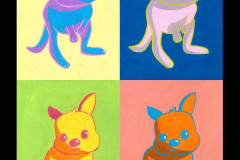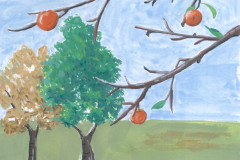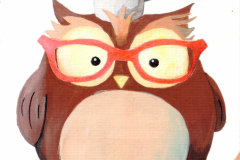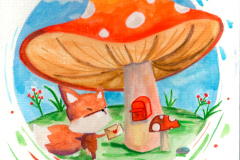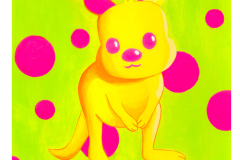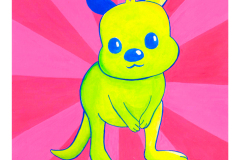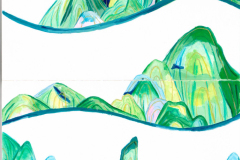Introduction
Gouache is a paint medium that offers unique qualities different from watercolor and acrylic. It contains natural pigment, water, and a binding agent, which creates an opaque paint. This opacity allows you to paint with solid colors that stand out on your paper, a feature useful for beginners exploring color and technique. Gouache has been a preferred choice for artists in many fields, including illustrations and comics, due to its quick drying time and ease of layering. Understanding these characteristics is essential to start painting with confidence and creativity.
Mixing colors with gouache requires some practice as it reacts differently when dry compared to when it is wet. The shades may shift, and matching colors can take effort. This guide offers practical tips and steps for beginners to learn about gouache painting and mastering color mixing. You will find clear instructions that help you handle gouache paint effectively, from preparing your materials to methods that make your paintings look vibrant and professional. Are you ready to enhance your painting skills with gouache?
Understanding Gouache Paint
Gouache paint is a water-based medium known for its opaque, matte finish. It contains a high concentration of pigments mixed with water and a binding agent, usually gum arabic. This mix creates a thick texture that covers surfaces fully, unlike watercolor, which is transparent.
When working with gouache, you will notice it dries quickly. This fast drying time lets you paint layers without waiting long. Gouache often dries slightly lighter than it appears when wet, so adjusting color intensity while painting is important.
Compared to acrylic paint, gouache remains reworkable with water after drying, allowing corrections and blending. This makes it popular for detailed illustrations and designs. Historical records show gouache has been used since ancient times, including in illuminated manuscripts and later in advertising and animation. Its versatility makes it a good choice when you want strong colors and fine control.
Composition and Characteristics
Gouache consists of pigments, water, and a binding agent that hold particles together. It uses more pigment than watercolor, which results in strong color that does not let the surface underneath show through. Its high pigment content also creates a thick, creamy texture that spreads evenly.
The paint dries with a matte finish, making colors look soft without shine. This differs from acrylic paint, which becomes glossy and plastic-like. Gouache can look lighter or darker when dry depending on brand and pigment. This means your painted colors might need small adjustments once dry.
Watercolors are transparent and rely on paper brightness to glow. Acrylics are durable and waterproof but lose some blending ease once dry. Gouache fits a middle ground: it offers opacity with water-based softness. Understanding these traits helps you choose the right paint for your project.
Common Uses and History
Gouache has a rich history extending back to ancient times, where it was used in Asian and European art for detailed illustrations and manuscripts. Artists favored it for its quick drying quality and ability to create vivid yet smooth colors.
Today, gouache finds use in poster making, illustrations, animation cells, and design work. It works well on various surfaces like paper, board, canvas, and even wood, making it flexible for different creative needs.
Have you considered how the paint’s erasable quality might fit your style? This feature appeals to artists who want to experiment and correct mistakes easily. Gouache continues to serve many artistic fields because of its adaptability and controlled finish.
Essential Gouache Painting Supplies for Beginners
Choosing the right materials impacts your gouache painting experience. Start with quality gouache paints that balance price and pigment strength. Many brands offer affordable starter sets that include basic colors like red, blue, yellow, white, and black. These colors cover most mixing needs for beginners.
Brush selection is equally important. Round brushes in sizes 4, 6, and 10 provide flexibility for detail and broader strokes. Synthetic brushes often work well with gouache because they hold paint without absorbing too much water. Flat brushes can help with sharp edges and filling larger areas efficiently.
Choosing Your Paints and Brushes
Focus on gouache tubes or pans labeled as artist or student quality. Student-grade paints are budget-friendly but check their opacity and pigment concentration. Pick primary colors that you can use to mix a wide range of hues. This practice sharpens your understanding of color blending.
A variety of brush shapes serve different tasks. Round brushes allow fine lines and smooth curves, while flat brushes help with washes and bold strokes. You won’t need many brushes at first; aim for a small set to practice control and technique.
Selecting Suitable Paper and Tools
Choose paper designed for heavier wet media. Gouache requires sturdy paper to avoid warping or tearing. Paper weight around 140 lb (300 gsm) works well, offering enough thickness for multiple paint layers. Rough or cold-pressed textures hold paint better, but smooth hot-pressed paper suits detailed work.
A palette with wells or a flat surface helps mix colors cleanly. Plastic or ceramic palettes work well and are easy to clean. A water container with a wide mouth allows you to rinse brushes thoroughly. Keep a cloth or paper towel nearby to control water on your brush effectively.
Preparing Your Workspace and Materials
Workspace Setup
Your workspace affects how smoothly your painting sessions flow. Arrange your brushes, paints, water containers, and paper within easy reach to avoid interrupting your focus. Consider using a small tray or organizer to keep everything tidy and prevent spills.
Good lighting helps you see colors accurately. Natural light is best, but if that’s not possible, use a bright, white light source placed above or beside your work area. Avoid harsh shadows that might distort shades.
Take time to clean your brushes and palette after each session. Keeping your tools clean preserves the quality of your paints and makes your materials last longer. Can you identify how a clutter-free area might improve your focus when painting?
Handling Gouache Paints
Mix your gouache with clean water to get the consistency you need. Thicker paint gives solid, opaque colors, while thinner paint creates smooth washes. Try mixing small amounts at first to avoid waste.
You can keep your gouache moist by covering your palette with plastic wrap or a damp cloth when not in use. This prevents the paint from drying out too quickly. How do you handle your paint drying time during breaks?
Work in layers, allowing the paint to dry between applications. Gouache dries fast but can reactivate with water, so wait before adding details or mixing colors on paper. Managing drying times well helps avoid muddy colors and keeps your painting clean.
Basic Gouache Painting Techniques
Getting comfortable with oils or watercolors might take time, but gouache offers unique methods that you can pick up quickly. Start by practicing washes. Mix your gouache with water to create a smooth, even layer of color. Apply the wash gently with a flat brush to cover large areas without streaks. Keep the layer thin and let it dry completely.
Once dry, you can add layers to build depth. Use thicker paint in subsequent layers to highlight shapes or shadows. Remember, gouache is opaque, so new layers can hide what’s underneath but still show subtle color changes if thinly applied. Experiment with opacity to see how colors change when layered.
Creating Washes and Layers
To make a flat color wash, mix gouache with plenty of water until the color becomes light and fluid. Apply it smoothly over paper, avoiding heavy brush strokes. Let this base dry fully before adding more paint. Try layering different colors on top; thin layers let some of the undercoat show, creating interesting effects.
Layering changes how colors appear. For example, a light blue wash covered with a thin yellow layer turns greenish. Thick layers block undercolors completely, letting you correct mistakes or add highlights. Think about your final image—will you want each layer visible or masked? Your use of opacity controls this.
Blending and Texture Effects
To blend colors smoothly, add a little water to your paint and work quickly while the surface is still wet. Use a soft brush to gently mix edges where two colors meet. Blending creates gradual shifts, ideal for skies or skin tones.
Texture can add interest and dimension. Try using the tip or side of your brush to create rough marks or dabs. You can also experiment with tools like sponges, palette knives, or even crumpled paper to press into wet paint. These techniques break smooth surfaces and give your work more character.
Fundamentals of Gouache Color Mixing
Understanding how colors mix with gouache helps you control your painting. Gouache is opaque; it covers well and lets you layer colors. When you mix paints, you create new shades that suit your vision. The basic rule is that primary colors—red, blue, and yellow—cannot be made by mixing other colors. They are the building blocks for all other colors.
Mixing two primary colors gives you secondary colors. For example, red and yellow make orange, blue and yellow make green, and red and blue make purple. Getting the right balance takes practice. Try mixing small amounts to see how the colors change.
Colors beyond primary and secondary are tertiary. These appear by mixing a primary and a neighboring secondary color. Tertiary colors produce variety and depth in your work. Learning how these mix helps you create color harmony or contrast in your pieces. Using a simple color wheel can guide you in choosing colors that work well together.
Think about your painting before mixing. Do you want colors that blend smoothly or stand apart? This question guides your mixing choices and overall composition.
Primary and Secondary Colors
Primary colors in gouache are red, blue, and yellow. You will use these most when mixing colors. Mixing equal parts of two primary colors creates a secondary color. For example, mix red and yellow to get orange. Try using more red or more yellow to shift the shade.
Blue and yellow create green. Adjust their amounts to make lighter or darker greens. Red and blue make purple, which can vary from a cool blue-purple to a warmer red-purple by changing the ratio.
Practice mixing each pair. Start by mixing equal parts, then change the ratio to notice how colors transform. You will get better results by eye rather than sticking to exact measurements.
Tertiary Colors and Color Harmony
Tertiary colors come from mixing a primary color with the nearest secondary color on the color wheel. For example, mixing yellow and green makes yellow-green, or mixing blue and purple makes blue-purple. These colors add richness to your palette.
Using tertiary colors helps your painting feel more natural and balanced. They offer harmony when placed near each other on the color wheel. Contrast appears by placing colors opposite each other, like red and green.
Before mixing, think about whether your painting needs harmony or contrast. Using a color wheel as a guide helps you understand which colors work well together and why. This tool makes your color mixing more intentional and effective.
Mastering Color Matching and Shades
Techniques for Color Matching
If you want to copy a color you see, start by mixing small amounts on a palette first. Use your brush to test the color in tiny patches before painting the main area. Look carefully at the original color’s lightness, warmth, and saturation. Try mixing two or three gouache paints in small steps, adding tiny amounts of each color to get closer to the target shade.
Check your test mixes in different lights. Sometimes colors look different under natural versus artificial light. Ask yourself: Is the color too bright, too dark, or too cool? Adjust by adding white, black, or warmer colors like yellow or red. Keep notes on your mixes. This helps you recreate colors later without guessing.
Managing Drying Color Changes
Colors in gouache look brighter and more vibrant when wet. They dry to a softer, flatter appearance because the water evaporates, leaving behind solid pigment. Expect your color to shift about 10% to 20% lighter or duller when dry. How can you handle this?
Mix your colors slightly darker or more intense than you want. Paint small swatches on scrap paper and let them dry. Compare the dry test to your desired color. Adjust the next mix based on what you learn. Avoid adding too much water; it makes colors look lighter and changes drying results.
Try layering colors once dry rather than relying on thick wet paint for strong hues. This approach gives you more control over the final shade. Watching how your colors change over several sessions will help you predict results better over time.
Common Challenges and How to Overcome Them
Many beginners face issues like cracking, unwanted blending, and dull colors when working with gouache. These problems can slow your progress if you don’t recognize their causes early. Are your layers cracking after drying? This might be due to thick paint or unsuitable paper. Is your painting losing its sharp edges or looking muddy? Blending could be uncontrolled or too much water was used. Are your colors turning dull after drying? This often means the paint was overwatered or the pigment quality is low. You can fix these issues by adjusting your materials and techniques. Paying attention to how you apply paint, the paper you choose, and the amount of water you use helps maintain the brightness and texture you want. What problem frustrates you the most when painting with gouache?
Preventing Cracking and Peeling
Cracking in gouache usually happens when paint is applied too thickly or on paper that can’t hold the moisture. Use heavyweight, cold-pressed watercolor paper to support the paint layers better. Avoid piling on thick paint; instead, build color gradually with thinner layers. Applying thick layers all at once traps moisture, causing the paint to crack as it dries unevenly. Dry layers completely before adding more paint on top. If you choose the right paper and layer your paint carefully, cracking and peeling will be less likely. Choosing inexpensive sketch paper or very smooth surfaces can make cracking worse. If cracking appears, try sanding the area very lightly after it dries and reapplying thinner paint layers. How can your choice of paper change your painting results?
Keeping Colors Vibrant and Controlled
Colors can look dull if you add too much water or mix paint on the paper after it starts drying. Limit water when mixing colors to keep the pigment strong. Mixing colors on your palette before applying helps maintain control. Use less water for sharper edges, and more water only when you want smooth blending. To keep edges crisp, paint a clean edge and let it dry before painting nearby. Avoid overlapping wet layers when you want separation. Brightness fades when colors blend too much or dry too thinly. Layer vibrant colors with dry waiting time between applications to keep them fresh. How do you adjust water and brushwork to control your painting’s look?
Developing Your Gouache Painting Style
Finding your unique gouache style means trying out different methods and being open to new ideas. Use your brush in varied ways—some strokes can be sharp and clear, while others soft and blended. See how layering colors can change the mood of your painting. Notice what feels natural to you and what challenges push you to improve.
Think about what makes you excited to paint. Do you prefer landscapes, bold abstracts, or detailed portraits? Use that interest to guide how you mix colors and apply paint. Your style will grow when you follow what you enjoy creating the most.
Ask yourself what mood or message you want to express with your gouache work. This will help you choose techniques and colors that fit your personal vision. Keep experimenting with different ideas so your painting style can develop naturally and confidently.
Experimenting with Techniques and Colors
Try different brush sizes and shapes to see how they affect your strokes. Use dry brushes for texture or add water for smooth blending. Mix colors on a palette and on paper to observe how they change. Try cool and warm colors next to each other to find interesting contrasts.
Change the order of paint layers to see how transparent or opaque effects appear. Mix limited colors to create your own palette instead of relying on many tubes. Track which combinations you like best for future reference.
If you feel stuck, switch from small details to broad shapes. Paint quickly to capture energy, then slow down to refine. Experimenting this way helps you find techniques that suit your style and mood.
Finding Inspiration and Practice Ideas
Choose simple objects around you like plants, cups, or shoes to practice shapes and colors. Paint different lighting times such as morning or evening to observe changes. Use photos, books, or online galleries for fresh ideas.
Try painting everyday scenes like streets or parks. Challenge yourself with small studies focused on specific colors or themes. Join local art groups or online forums to share work and get feedback.
Ask yourself what subjects make you feel curious or calm. Use those feelings as a starting point. With regular practice on subjects that interest you, your skills and style will strengthen steadily.
Conclusions
Your journey with gouache painting begins with grasping the basics, including how the paint behaves on your chosen surface and how to mix colors accurately. Practicing these skills regularly will improve your ability to express your ideas with color and design. Remember that each attempt teaches you more about the medium and your artistic preferences. Stay curious about how different pigments interact and how layering affects the final appearance. This knowledge forms the foundation for more advanced work.
By applying these beginner tips and keeping your approach practical, you will enjoy painting with gouache and create artworks you can be proud of. How will you use your new understanding to explore new subjects and styles? Your experience with gouache can open doors to various art forms, from portraits to abstract designs. Embrace the process, and let your creativity grow with every brushstroke.


















